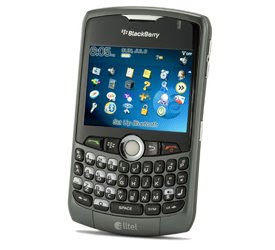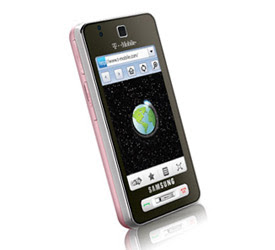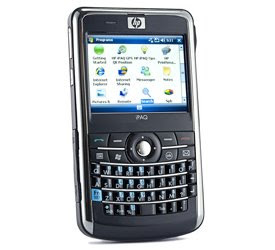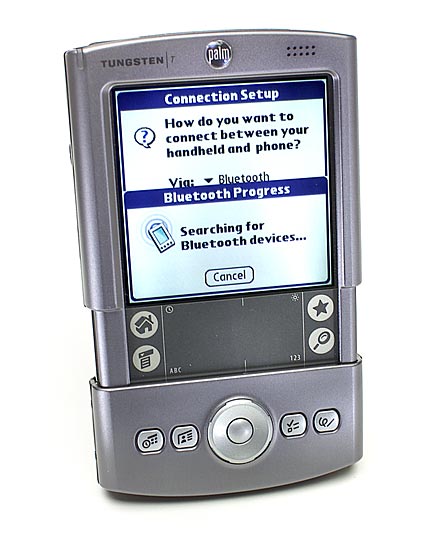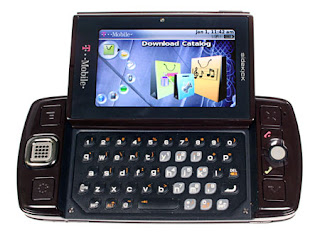 Overview
OverviewThe m130 is Palm's new color mid-range model from Palm. It offers a fast processor and an SD/MMC slot for memory expansion. It is the first non-high-end Palm model to have a color screen.
It is basically an m125 with a color instead of a monochrome screen. But what a difference that little change makes.
Exterior
The m130 gets most of its external appearance from the m100 series. It has the same curvy shape. It is small but not super-slim by any stretch of the imagination. If you want the exact dimensions, it is 4.8 by 3.1 by .9 inches, which is exactly the same size as the m125. It weighs 5.4 ounces, just slightly heavier than the m125.
I think there is an important tradeoff that gets overlooked in handheld design. What fits best in your pocket generally isn't what fits best in your hand. The m100 series sits in my hand much better than any other handheld. But much slimmer handhelds are easier to carry around. The m130 goes much better in a backpack or purse than it does in a pants pocket.
It can use the removable faceplates designed for the m100 series so it can be personalized to fit your taste. There are quite a few of these available, from very conservative to quite outrageous. The faceplate that comes on the m130 is in the conservative category, being a silver with blue around the edges.
The Power button is at the top in the middle.The hardware buttons are nicely sized and neither too easy nor too hard to push. They help makes this a decent handheld for playing games.
Alone of the Palm OS licensees, Palm still hasn't embraced the jog wheel. Maybe someday...
Screen
The m130's screen gets maligned because it is a bit smaller than the standard. It has the usual 160 by 160 pixels; they are just packed into less space. I don't think it deserves a bad rap. The slightly smaller screen actually makes fonts look a bit better because the pixels are smaller and closer together. This means letters look less bitmappy. Of course, this assumes you have good eyesight. If you regularly use reading glasses, smaller fonts are probably not something you are looking for.
The screen absolutely depends on having a backlight. Without one, the screen is utterly unreadable. In fact, there is no way to use the handheld with the backlight off. It has two settings, high and low. Holding down the Power button toggles between these. The only time the backlight is off is when the handheld itself is off.
Indoors, the screen looks very good. It displays colors well, and, even with the backlight on low, it's brighter than an m505. Contrast is excellent so reading text is a breeze. The screen does have a slight bluish tint to it.
The image on the right shows an m505 and an m130. The picture was taken in low light. The sidelight for the m505 is on and the m130's backlight is on low.
Unfortunately, I can't say many good things about how the m130's screen looks outdoors. Like I said, the m130 depends on a strong backlight and if the ambient light is brighter than the backlight, it is difficult to read the screen. I'm not saying the screen is unusable outdoors. If you needed to look up a phone number, you could. But you won't be lying out in the hammock reading an eBook.
This is about the only real flaw in the handheld. While I realize that this will kill the deal for some people, I don't think the typical user regularly uses their handheld for long periods of time outdoors.
Even indoors, the screen suffers from "ghosting". Moving items, like in games, leave a trail behind them. This sometimes makes it difficult to read moving text but that doesn't come up very often.
The Graffiti area isn't backlit.
Battery
In any review of a handheld with a color screen, battery life is an important issue. In an earlier review, I tried to get a feel for battery life with a very unrealistic torture test, where I kept the handheld on continuously. This isn't the way most people use their handhelds so this time I came up with a much better one to test the m130's internal Li-ion rechargeable battery..
I loaded onto it an app called Uptime 1.3.1. Among other things, it tracks how much time a handheld has been on. Its timer stops running when the handheld is off.
Then I just used my handheld normally. I played some games, I read AvantGo channels, my alarms went off as normal, etc. while the app was tracking how much use the handheld was actually getting. This gave me a much better picture of actual battery life than keeping the m130 on continuously.
First, I used it with the backlight on full power. After almost exactly 4 days since its last recharge, I got my first battery warning at 5 hours and 32 minutes of use. I got another warning after 5 more minutes of use and after about 5 hours and 45 minutes it shut itself down.
Next I set the backlight on dim. This gave me 10 hours and 20 minutes of use before the first warning but didn't shut itself down until I had used it for 11 hours and 11 minutes. This took almost 5 days of heavy use.
In case you are wondering, a full charge is 4.21v. I have it set to give its first warning at 3.74v and shut down when it gets below 3.72v.
SD/MMC Slot
One of the best features of the m130 is the expansion card slot. This allows huge amounts of files and applications to be stored and available for use relatively easily.
The support for memory cards built into the OS is decent but not outstanding.
When an SD or MMC card is inserted into the handheld, a new category is created in the Launcher. This is named the same as the expansion card. There is no way to create sub-folders or different categories of apps on the SD card; they are all listed together.
Some applications can be run from the card but what really happens is the app is copied into RAM, run from there, then deleted out of RAM. This won't work for large apps that are made up of several different parts, like AvantGo.
Before you experts fire off an angry comment, I'm talking about what is possible in the Launcher built into the Palm OS. There are quite a few applications out there that allow expansion cards to be much more useful. Going through the whole list is way beyond the scope of this review but I suggest McFile for moving files around and Launcher III for launching apps. They are a good place to start for beginners.
An odd fact about the m130's SD/MMC card slot is that it is on the side of the handheld, not the top as we have come to expect from other handhelds with expansion slots. For most people this won't be a problem, as regular memory cards fit fine. But SD Input/Output devices, like the Bluetooth card, will extend well beyond the confines of the slot itself. Users of these will pretty much have to remove them before putting the m130 away.
I can tell you I carried an m130 around in my pocket for almost two weeks with an SD card in it and never had a problem.
Before I move on, I want to point out that you remove an SD or MMC card from the m130 by pushing it in, then letting it pop out a bit. Do NOT yank it out of the slot with main force. You will break the slot, requiring your entire handheld to be shipped off for repair.
Rugged
Unlike most handhelds, the m130 has actually been designed to survive the conditions handhelds are regularly put through. The casing is larger than many other handhelds because it kind of has a built-in hardcase. Also, the screen is plastic instead of glass to make it much harder to break. This makes a heck of a lot of sense to me. While many high-end models may get carefully coddled in expensive hard cases, most low- and mid-range ones get jammed straight into book bags or purses. Palm was smart to design this series so that it doesn't need any extra protection.
Take a quick look around and you will find all kinds of cases for handhelds but you'll find very few designed for the m100 series. That's because the people who make cases understand that these models really don't need one very much.
Internal
The m125 runs OS 4.1 on the 33 MHz Dragonball processor. It has 8 MB of internal memory, which is about half what I think it ought to have. Palm really should have gone ahead and put 16 MB of RAM in this. This isn't a critical lack because expansion memory will help compensate but 16 MB is what we expect these days.
One feature that is controversial is its lack of flashable ROM. This means the OS can't be upgraded. This probably isn't as big a deal as some people think it is. There isn't going to be another major OS upgrade that the m130 could run even if it did have flash ROM. Palm is working now on OS 5, which is designed for handhelds running ARM-based processors. There's no point in making an upgradable handheld if there probably won't be anything to upgrade it to.
But that doesn't mean the m130 will be junk in six months. Palm OS 5 will be backwards compatible with current apps so m130 users won't suddenly be unable to use all the new Palm apps. Keep in mind, though, there will almost certainly be high-end apps out late this year that this mid-range model won't be able to run. But it is only the very high-end ones that this will be true of, like some games and video players.
Software
Of course the m130 comes with a bunch of useful applications but the most significant of these is DataViz' Documents To Go 4.0 Professional Edition. This allows users to transfer Word and Excel files onto their handheld and work with them there. On the next HotSync, the original document or spreadsheet on the desktop gets updated with any changes made. Docs to Go is neither my favorite word processor nor spreadsheet app but it is hard to compete with free. And it does a very good job of updating the Windows files without losing any formatting. I've read several reviews that said Docs to Go is better than Microsoft's Pocket Word. Windows users can view Microsoft PowerPoint presentations, too.
It also comes with MGI PhotoSuite for displaying pictures. These look good on the m130's color screen and it's handy to always have the pictures from your last vacation with you.
They updated the Note Pad for this model, too. This is the little app that lets you draw notes to yourself, rather than having to write them. It has come in handy for me plenty of times. Too bad the changes they made to it are almost useless.
They added the ability to change the color of the the background and line color for all notes, but not each individual note. So you can make the background on all your notes green but you can't make the background on one green and another blue.
Universal Connector
The m130 uses the Universal Connector, first seen on the m500 series. This allows the m130 to use most peripherals designed for the m500 series that connect to the HotSync port.
For example, I never even bothered to connect the m125's cradle up to my computer; I've been using the one for my m505 with no problems. I've also used it with my Stowaway folding keyboard and the Kodak PalmPix camera that have the UC.
I think Palm's move to standardize on the UC is one of the best moves the company has made. I've heard so many complaints from people who don't want to upgrade because they would have to buy all new peripherals. Palm will be using the UC for at least the next couple of years so you can buy your peripherals with confidence that you'll be able to use them on your next Palm model, too. Unless you are waiting until 2005 to buy it.
I wish Palm would let other companies use the UC, too. It would be great for peripheral makers if they could make one keyboard or GPS module and know that everyone can use it, whether they have a Clié, Visor, or whatever. It's not too likely, though. One of Palm's big advantages is there are far more peripherals for its models than for its competitors.
While the m130 can use many of the same peripherals as the m500 series, this means it can't use the ones designed for the m100 series. This is going to cause confusion for buyers. Packages that say "Works with the Palm m100 Series" are all going to have to be changed. It might have been simpler if Palm had just called this the m305 and pointed out that it can use some m500 peripherals and some m100 ones.
I'll try to help clear some of this up. The m130 can use the faceplates and flip covers for the m100 series. It can't use the m100 series styli. It is slightly thicker than the m100 series, which means many cases won't fit, either. Anything that needs to connect to the HotSync port, like a modem, needs to use the Universal Connector.
Of course, some products don't say they use the UC; they just say they are for the m500 series. And some that have been designed for the m500 series won't work with the m130. See why I said this is going to cause confusion? If there is any doubt, contact the manufacturer or visit their website to find out if the product is m130 compatible.
Tis is going to get a little easier as the older m100 series models, which don't have the UC, get discontinued. As it is, any peripheral that works with the m125, also works with the m130.
Infrared Port
Of course, the m130 has the standard infrared port that is on all Palm powered handhelds. It also comes with the Mobile Internet Kit so if you have a mobile phone with an IR port, you can use it to wirelessly access the Net. It uses Palm's Web Clipping technology to get information from websites. I had to install it from the CD first, though. I then loaded the Palm Infocenter Web Clipping app onto the m125 to try it out and had no problems.
Plus you can use the IR port for the standard stuff, like beaming apps and files to other handhelds.
Peripherals
The flip cover has the same general design as the one from the m100 series, but isn't exactly the same. It is made of a semi-rigged plastic. It has a clear window in it and an opening for the Up button. This allows you to use the m130 as a pocket watch. You can pull it out of your pocket or purse and without opening the cover, push the Up button to display the time and date in the window. Very convenient.
The stylus is particularly cheap. It is essentially a solid bit of plastic. There is no reset pin built into it.
The cradle is the same one that ships with the m500 series. It has been described as looking like a slipper and I think this is accurate. Like I said, I used the cradle from an m505 without a hassle.
While I'm on the topic of cradles, I ought to point out that I've never heard of a case of the m130 or m125 suffering from the USB problems some m500 series models do.
Conclusion
At $280, I think the m130 is an excellent deal. It is the least expensive color Palm OS handheld you can get.
I think this is a good handheld for a high school or college student. Of course, students aren't the only people who might like an m130. It is right for anyone who wants a color handheld with a lot of storage who doesn't want to spent $400 to get it.



